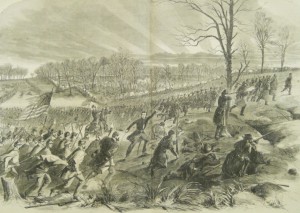Regimental histories can provide a lot of information regarding our Civil War ancestors, and are often overlooked in research. Compiled by many Civil War veterans in the years after the war, these histories can provide new insight into their service, far beyond what might be found in military records.
My ancestor, John Doerfler, emigrated from Germany in 1857 with his wife Margaretha. He was a weaver, and eventually settled in Lawrence, Massachusetts, where he worked in the woolen mills. At the outbreak of the Civil War, he enlisted as a private in Company I of the 2nd Massachusetts Infantry, the same infantry in which Robert Gould Shaw served before joining the famed 54th Massachusetts. Throughout the Civil War, the 2nd Massachusetts participated in several key battles, including Antietam, Chancellorsville, and Gettysburg.
Alonzo Hall Quint, the 2nd Massachusetts Infantry’s chaplain, published a history of the regiment entitled The Record of the Second Massachusetts Infantry, 1861–5. In the preface he wrote, “But this record is made for men to whom every date is a scene, and every name a comrade; for widows and orphans, and for childless parents. Their experiences will fill up the outline.”[1]
In this volume, a reference to my ancestor was included:
Doerfler, John. 30. Germany. Weaver. 18 May, 1861. Lawrence. – Wounded in knee, 24 May, 1863, at Kernstown, Va.; transferred to Invalid Corps, 1 Sept., 1863.[2]
John Doerfler was born about 1817, so in 1861 he would have actually been in his mid-40s. Also, the Battle of Winchester, fought near the town of Kernstown, occurred 24 May 1862, not in 1863. Despite these two small discrepancies, the information regarding John was very useful.
I wanted to learn what Quint had written about the 2nd Massachusetts Infantry’s engagement at the Battle of Winchester, and what my ancestor might have faced when he was injured. Quint wrote that the 2nd Massachusetts was called in to relieve Major General Nathaniel Banks’ troops, who were being pursued by Confederate General Stonewall Jackson on the Valley Pike Road between Strasburg and Winchester in Virginia’s Shenandoah Valley.
Quint wrote:
A little farther on, at Barton’s Mills, Company I relieved A and C, that they might take their knapsacks, left there before turning to Newtown. Again the cavalry came on: Company I opened fire: again the cavalry fled. “So severe a fire,” says Dabney, “that the cavalry advance retired precipitately out of it, carrying the General and his attendants along with them, and riding down several cannoneers who had been brought up to their support.” Then the enemy’s infantry appeared. “Three regiments of the ‘Stonewall’s Brigade,’” says Cook, “were thrown forward,” who “attacked with great gallantry; and heavy firing ensued.” “So pertinacious was the stand of Federalists here,” says Dabney, “the 27th, 2nd, and 5th Virginia regiments were brought up; and the affair grew to the dimension of a night combat before they gave way.” It was a combat between three regiments of the famous Stonewall Brigade, and Company I, with D as flankers, re-enforced on the sides of the road by Companies B and C, the whole under Major Dwight of the Second Massachusetts. The regiment accomplished the object of the halt, and moved on.[3]
During this skirmish, it was very likely that John Doerfler received the wound to his knee, as Company I battled Stonewall’s Brigade. For me, it is difficult to imagine so chaotic a scene. Yet scenes like this occurred in nearly every battle during the Civil War, and were a common experience for most soldiers. Today, these regimental histories are invaluable, as they allow us to gain new perspective into our ancestors’ hardships and service. Here at NEHGS, we have many regimental histories in our collection. Many have been digitized too, and are available on Google Books or Archive.org.
As for John Doerfler, he survived the Civil War and returned home to Massachusetts. He was naturalized as a citizen of the United States in 1867 and eventually settled in Haverhill, where he owned a farm. In 1878, he was admitted to the National Home for Disabled Volunteer Soldiers at Togus, Maine. On his admission form, he noted that he received a shell wound in his right leg at the Battle of Winchester. He died the following year of heart disease, and is buried in the Bellevue Cemetery in Lawrence.
Notes
[1] Alonzo Hall Quint, The Record of the Second Massachusetts Infantry, 1861–5 (Boston: James P. Walker, 1867), vi.
[2] Ibid., 407.
[3] Ibid., 85–86.
Share this:
About Sheilagh Doerfler
Sheilagh, a native of Chelmsford, Massachusetts, received her B.A. in History and Communication from the University of Massachusetts-Amherst. Her research interests include New England, Norway, Sweden, Ireland, Westward Migration, and adoptions.View all posts by Sheilagh Doerfler →
